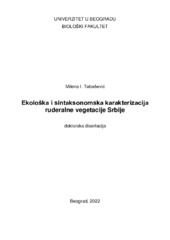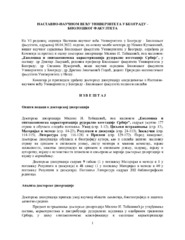Приказ основних података о дисертацији
Ekološka i sintaksonomska karakterizacija ruderalne vegetacije Srbije
Ecological and syntaxonomic characterization of ruderal vegetation in Serbia
| dc.contributor.advisor | Kuzmanović, Nevena | |
| dc.contributor.other | Lakušić, Dmitar | |
| dc.contributor.other | Vukojičić, Snežana | |
| dc.contributor.other | Jenačković Gocić, Dragana | |
| dc.creator | Tabašević, Milena | |
| dc.date.accessioned | 2023-02-24T19:42:09Z | |
| dc.date.available | 2023-02-24T19:42:09Z | |
| dc.date.issued | 2022-09-20 | |
| dc.identifier.uri | https://eteze.bg.ac.rs/application/showtheses?thesesId=8958 | |
| dc.identifier.uri | https://fedorabg.bg.ac.rs/fedora/get/o:28015/bdef:Content/download | |
| dc.identifier.uri | https://plus.cobiss.net/cobiss/sr/sr/bib/108465417 | |
| dc.identifier.uri | https://nardus.mpn.gov.rs/handle/123456789/21206 | |
| dc.description.abstract | Ruderalna vegetacija se spontano razvija pre svega u gradskim, ali i drugim sredinama, u kojima su uslovi izmenjeni usled antropogenog uticaja. U ovoj disertaciji je istraživana ruderalna vegetacija u 20 gradova širom Srbije, u periodu od pet godina. Fitocenološki snimci su zabeleženi na standardizovanim površinama, na različitim tipovima ruderalnih staništa. Set od 712 snimaka u kojima je zabeleženo prisustvo 422 taksona je podvrgnut klaster i ordinacionim analizama. Primenom hijerarhijske klasifikacione analize ustanovljeno je prisustvo 27 zajednica, klasifikovanih u 11 sveza, 9 redova i 6 vegetacijskih klasa. Izdvojene zajednice su ekološki jasno okarakterisane, a sastav vrsta odražava uslove u kojima se one razvijaju. Stepen narušavanja utiče na strukturu zajednica, te se sa povećanjem intenziteta narušavanja povećava zastupljenost jednogodišnjih vrsta. Strani taksoni za istraživano područje čine 19% od ukupnog broja registrovanih taksona, i u 9 zajednica oni dominiraju ili kodominiraju. Analiza bioklimatskih faktora je pokazala da diferencijacija analiziranih ruderalnih klasa nije uslovljena klimatskim karakteristikama. Sintaksonomska revizija ruderalne vegetacije je urađena na objedinjenom setu podataka koji je, pored originalnih snimaka, uključio i snimke iz različitih literaturnih izvora publikovanih u poslednjih 70 godina u Srbiji. Na osnovu razlika u kvantitativnom i kvalitativnom sastavu taksona, klasifikacionim analizama ustanovljeno je 65 zajednica svrstanih u 15 sveza, 11 redova i 7 vegetacijskih klasa (Bidentetea, Digitario sanguinalis–Eragrostietea minoris, Sisymbrietea, Polygono–Poetea annuae, Artemisietea vulgaris, Epilobietea angustifolii, Salicetea purpurea). Za izdvojene sveze određene su dominantne, dijagnostičke i konstantne vrste. | sr |
| dc.description.abstract | Ruderal vegetation spontaneously develops in urban and other areas with heavily altered conditions, due to anthropogenic impact. In this dissertation, ruderal vegetation was investigated in 20 cities across Serbia, over a period of 5 years. Phytosociological relevés were collected from different types of ruderal habitats on standardized plot sizes. A set of 712 relevés, in which the presence of 422 taxa was recorded, was subjected to cluster and ordination analyses. Based on the results of hierarchical classification analysis, the presence of 27 communities was identified, which were classified into 11 alliances, 9 orders, and 6 vegetation classes. The identified communities are ecologically well-differentiated and species composition clearly reflects the conditions in which these communities develop. The degree of disturbance directly affects the structure of communities and the representation of annuals increases with the higher level of disturbance. Alien taxa for the study area make up 19% of the total number of registered taxa and in 9 communities aliens dominate or co-dominate. The analysis of bioclimatic factors showed that the differentiation of the analyzed ruderal classes is not conditioned by climatic characteristics. Syntaxonomic revision of ruderal vegetation was performed on a combined set of data, which in addition to the original relevés also included relevés from various literature sources published in the last 70 years from the territory of Serbia. On the combined data set with 1307 phytosociological relevés and 671 taxa, 65 communities were classified into 15 alliances, 11 orders, and 7 vegetation classes (Bidentetea, Digitario sanguinalis–Eragrostietea minoris, Sisymbrietea, Polygono–Poetea annuae, Artemisietea vulgaris, Epilobietea angustifolii, Salicetea purpurea). | en |
| dc.format | application/pdf | |
| dc.language | sr | |
| dc.publisher | Универзитет у Београду, Биолошки факултет | sr |
| dc.rights | openAccess | en |
| dc.rights.uri | https://creativecommons.org/licenses/by-nc-nd/4.0/ | |
| dc.source | Универзитет у Београду | sr |
| dc.subject | ruderalna vegetacija | sr |
| dc.subject | uderal vegetation | en |
| dc.subject | gradovi | sr |
| dc.subject | Srbija | sr |
| dc.subject | ekološke karakteristike | sr |
| dc.subject | sintaksonomija | sr |
| dc.subject | revizija | sr |
| dc.subject | alohtone vrste | sr |
| dc.subject | invazivne vrste | sr |
| dc.subject | cities | en |
| dc.subject | Serbia | en |
| dc.subject | ecological characteristics | en |
| dc.subject | syntaxonomy | en |
| dc.subject | revision | en |
| dc.subject | non-native species | en |
| dc.subject | invasive species | en |
| dc.title | Ekološka i sintaksonomska karakterizacija ruderalne vegetacije Srbije | sr |
| dc.title.alternative | Ecological and syntaxonomic characterization of ruderal vegetation in Serbia | en |
| dc.type | doctoralThesis | |
| dc.rights.license | BY-NC-ND | |
| dc.identifier.fulltext | http://nardus.mpn.gov.rs/bitstream/id/149652/Disertacija_13270.pdf | |
| dc.identifier.fulltext | http://nardus.mpn.gov.rs/bitstream/id/152640/Referat.pdf | |
| dc.identifier.rcub | https://hdl.handle.net/21.15107/rcub_nardus_21206 |



